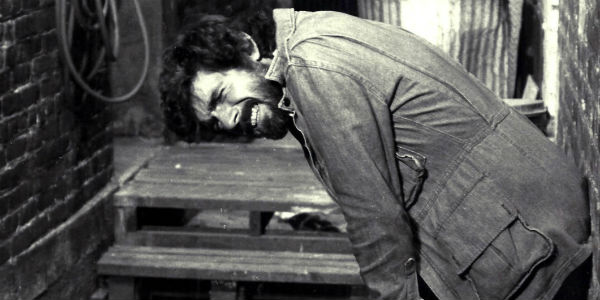The costs of being honest: what Serpico can teach us about reducing corruption
Although bureaucratic corruption plagues many countries, researchers struggle to recommend ways to deter it. Aksel Sundström argues that the effect of violent intimidation by people trying to bribe enforcement officers has been largely overlooked. He suggests that protection schemes for officials may have the potential to reduce the costs of honest behaviour.

David Birney as Serpico in the eponymous TV series, 1976. Photo: NBC Television (eBay item photo front press release). Public domain via Wikimedia Commons
In remote parts of countries like Mexico or Afghanistan, widespread bribery involving customs officers, policemen or civil servants fuels criminal behaviour such as smuggling. Tackling this kind of institutionalised corruption is one of the main challenges impeding social progress in countries where the rule of law is weak. Using qualitative interview data from places where corruption and violent intimidation are endemic, I tried to gain further understanding of the problem.
While corruption is a topic of immense interest for policy-makers, there are gaps in our understanding of how we can reduce it. Perhaps more fundamentally, do we understand the drivers of small-scale corruption in the first place? Not only are we struggling to find the right cure for this sickness, but we also have trouble diagnosing it in the first place.
So why do officials accept bribes from people who want to break the law? The anti-corruption discussion has usually focused on civil servants’ calculation that the gains from corruption will outweigh the potential risk of getting caught, and the potential ramifications of losing their job. According to this interpretation, the solutions include increased salaries, higher penalties for wrongdoers and more elaborate monitoring. Others have suggested that bribery may also be a problem of collective action, where very few officials in a highly corrupt administration want to be the only ones who do not take bribes.
But do these explanations take violent contexts into account? Returning to the situation of a customs officer in Mexico or Afghanistan, these perspectives seems to pay insufficient heed to the role of violence and the physical security of officials. A bureaucrat in such a setting is likely to come under pressure from criminals who wish to break the law. In the political sphere, previous studies have used the term plata o plomo (Spanish for “silver or lead”), meaning “your money or your life”, to signify situations where agents were forced to engage in corrupt practices. This is relevant to our understanding of bureaucratic corruption too.
In a recent article for Public Administration, I focused on a South African government authority faced with the challenge of enforcing regulations to hinder poaching in the marine sector. During 2014, I interviewed inspectors working in rural areas – who were asked to talk freely, and promised anonymity. They described the difficult conditions in which they work:
“Last week some person there threatened us with stones. So we just had to let him walk away with poached resources. See this scar [shows his chin], a poacher cut me here two years ago” – (anonymous inspector).
“[Fishermen may] threaten that they are going to burn your house. This happened to a colleague … There was a case a while back when poachers kidnapped the wife of an inspector. This inspector was enforcing too. So there is a balance” – (anonymous inspector).
In practice, this ‘balance’ often means that inspectors start to be pragmatic when enforcing rules. Being lax with fishermen who violate rules is, in such a situation, the easier choice:
“[A colleague] approached some guys who were coming up from the water. And he was stabbed … You cannot be too headstrong. If I see poaching I say to them kindly to throw it in. And I will not write a fine … So you show a nice attitude” – (anonymous inspector).
It is in such situations that violence seems to affect the decision of whether to accept a bribe:
“Since we work in a dangerous community with poaching, it’s a choice between honest work and a relaxed lifestyle where you turn a blind eye or become a part of this business [of accepting bribes]” – (anonymous inspector).
Inspectors who collude with poachers work as informants, sharing information about enforcement operations. This has consequences for inspectors who refuse bribes:
“Three years ago I did a bust and it went bad. They threw a firebomb, burning me. And we exchanged gunfire. So they put a price on my head … I had to move to this station. And the sad thing is that it was my own people who had tipped them off, sharing information about this operation” – (anonymous inspector).
These interviews show that corrupt actors seem to prefer inspectors to engage in corruption rather than just standing by. One explanation could be that the number of potential whistleblowers decreases as the number of bureaucrats on payrolls rises.
The pressure from corrupt colleagues is also visible:
“Being the only inspector at a station that does not accept bribes and that enforces rules hard, it is dangerous. You will be a threat to the livelihood of inspector colleagues … So you might be threatened because of this” – (anonymous inspector).
Accepting bribes solves many of these problems, and cuts down the number of threats:
“If you take bribes you are protected. You have a role in the community. You got organisation protection and police protection. In the community this is a social thing. They will start helping you. Some inspectors even help the poachers drive their vehicles. So it’s protection, social protection” (anonymous inspector).
Given ignoring rule violations is easier than enforcing the law, some of the inspectors explained that the choice to take bribes may reduce the threats from fishermen:
“Our personnel are scared to confront poachers … Instead [of enforcing rules] you start becoming less proud and ethical” – (anonymous inspector).
In the light of such accounts, it is questionable that a higher salary or harsher punishment would mitigate the problems facing these officials. What might work better is the introduction of protection schemes for law enforcement personnel. They often live near the people who are threatening them. Threat assessments might increase the security of officials in such contexts, and how to design such schemes is an important task for future research.
South Africa is not the only country where there are costs associated with honesty. There are similar anecdotes from administrations in richer parts of the world. The New York City Police Department in the 1960s was made famous by the Hollywood movie Serpico, starring Al Pacino. In reality, Frank Serpico – a patrolling policeman who received death threats and became a pariah among colleagues after testifying about corrupt practices – witnessed in 1971 the consequences of refusing bribery: “The atmosphere does not yet exist in which an honest police officer can act without fear of ridicule or reprisal from fellow officers”, he said (quoted in the New York Times, 2010).
Full article: Sundström, Aksel (2016) “Violence and the costs of honesty: Rethinking bureaucrats’ choice to take bribes” Public Administration, 94 (3): 593–608.
This post represents the views of the author and not those of Democratic Audit.
 Aksel Sundström (PhD, 2015) is a postdoctoral researcher affiliated to the Quality of Government (QoG) Institute, University of Gothenburg, Sweden. His dissertation focused on corruption in public administrations in developing countries.
Aksel Sundström (PhD, 2015) is a postdoctoral researcher affiliated to the Quality of Government (QoG) Institute, University of Gothenburg, Sweden. His dissertation focused on corruption in public administrations in developing countries.
More by Aksel Sundstrom:
In places where corruption is endemic, women struggle to become local councillors





 Democratic Audit's core funding is provided by the Joseph Rowntree Charitable Trust. Additional funding is provided by the London School of Economics.
Democratic Audit's core funding is provided by the Joseph Rowntree Charitable Trust. Additional funding is provided by the London School of Economics.
The costs of being honest: what Serpico can teach us about reducing corruption https://t.co/yigS2yOnGf
‘Why do officials accept bribes from people who want to break the law?’ New findings | Aksel Sundstrom @goteborgsuni https://t.co/E6HwcPczMe
“The costs of being honest: what Serpico can teach us about reducing corruption,” @democraticaudit https://t.co/CZUuiaUxjU
Why public officials succumb to bribes – and what governments can do about it https://t.co/E6HwcOUYnE
The costs of being honest: what US cop Serpico can teach us about reducing corruption https://t.co/E6HwcPczMe
The cost of honesty: what Serpico can teach us about reducing corruption https://t.co/TYvyHZDFfz via @rightrelevance thanks @democraticaudit
The costs of being honest: what Serpico can teach us about reducing corruption https://t.co/E6HwcPczMe https://t.co/pJIrddkGRm